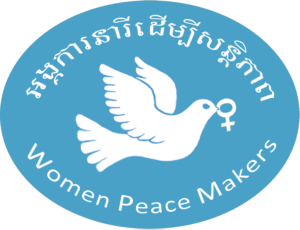Luon Then, 52, is from the Toeuk Sap community of Prey Nup district, Kompong Som province. She is a child survivor of the Khmer Rouge regime whose father was killed and mother became mentally ill.
Ms. Then grew up in a Khmer family holding traditional gender norms and values. In early the 1980s when she innocently told her mother of her having first period, her mother instantly forced her into practicing “Chol Ma-lup”, an old traditional practice of keeping the first-time menstruating girl isolated and inside. Her mom told she was now on the path of “fulfilling the duty” (Krup Chbap Kar) to get married at the age of 15 years-old. She was locked up in a small hut nearby the family’s house, where she had to sleep, eat, and relieve herself all in the same small space. Inside the hut, she was taught how to learn to sew, cut, and make cloth – the skills she needed to prepare for becoming a wife. “It was tough and uncomfortable living in that hut,” she says. Yet, she explains she had no choice and followed her mother’s orders.
On that last day of her confinement, there was a big celebration where she learned about her upcoming arranged marriage. This is how her life was planned and she continues to live with that to this day. Life in the 80s and 90s was about surviving. Though she did get used to her situation, she has faced a new type of repression in contemporary times: land conflict.
Growing up witnessing violence as a part of life, Ms. Then adopted an understandably reactive violent response to threats against her. “My experience at a young age shaped the way I have always behaved. I was a very unreasonable and nasty girl. Very reactive, usually in a violent way. I even fought an authority who threatened to stop me from building my house. I didn’t listen to any reason. Resorting to violence has always been a part of me.” Nonetheless, she continues, “lately, things seem to encourage me to rethink of my behavior after all the learning on active non-violence with WPM. It had been very beneficial for me since I started to apply some of these new things into my daily routine. I see myself changing now. At home, I’ve started to learn to control my anger and not just respond violently.” Ms. Then say she has started reflecting on her behavior and realizes that violence is a choice. She sees it now as something bad that brings negative impact on her and others around her.
By gradually practicing nonviolence, I notice that my life has changed,” she shares. “Since I began to know how to calm myself down in time of crisis, I feel better. In my family there is no more throwing things and I stop fighting with my husband and stop myself from responding violently over any arguments. I keep calm and try not to argue with him when he is not in a normal state of mind, especially, when he’s drunk as he also become violent. I talk to him the next day instead. Such practice of nonviolence allows us as a family to feel more happiness. I just wish he would stop drinking.”
Equipped with such knowledge, Ms. Then is now more confident to help prevent and address family conflict in her community, especially domestic violence cases. She adds, “I understand other and always step back and see how they are feeling. If I go there and they don’t seem to get my point, I have to be mindful and give them some space before I start a conversation once again. They do tend to listen to me when I try to understand them. In case of arguments, I first find way to prevent them from fighting and then try to talk to both sides to influence their view and help them see each other as friend again.”

